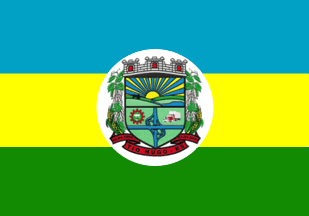 image by Ivan Sache, 7 August 2020
image by Ivan Sache, 7 August 2020
Last modified: 2020-08-08 by ian macdonald
Keywords: rio grande do sul | tio hugo |
Links: FOTW homepage |
search |
disclaimer and copyright |
write us |
mirrors
 image by Ivan Sache, 7 August 2020
image by Ivan Sache, 7 August 2020
The municipality of Tio Hugo (2,724 inhabitants in 2010; 11,420 ha) is
located 250 km north-west of Porto Alegre.
The municipality of Tio Hugo was
established by State Law No. 10,764 promulgated on 16 April 1996, separating
from Victor Graeff, Ernestina and Ibirapuitã, and inaugurated on 1 January 2001.
The municipality's odd name (Uncle Hugo) is connected to the building of
road BR386, which was completed in 1968. In 1963, Hugo André Loreno established
at km 214 a petrol station on behalf of the national company, Petrobrás.
Extremely appreciated by his customers, neighbors and friends, he was nicknamed
Uncle Hugo. The town developed by the Rabello company during the building of
road 386 was soon named for him.
https://tiohugo.rs.gov.br/
Municipal website
Ivan Sache, 7 August 2020
A blue-yellow-green horizontal tricolour with the municipal coat of arms centred
in a white oval.
Dirk Schönberger, 24 April 2012
Yellow represents wealth.
Red represents justice and power.
Green
represents the natural environment.
White (silver) represents prudence and
history.
Blue represents life and fraternity.
Black represents prudence
and protection.
On the coat of arms, the sun represents dawn, life and
resources.
The hills represent the arable lands, the base of agriculture in
the municipality.
The river and the lake represent the source of energy that
boosts hydro-electricity, a legacy of the municipality's territorial division.
The cogwheel represents Industry and Commerce.
The cloverleaf interchange,
the municipality's landmark, highlights the importance of the municipality's
location for its prosperity.
The truck transporting good represents the
municipality's existence.
The soybean and wheat plants, the bovine and the
bird represent the main sources of income for the rural estates.
The scroll
represents protection and justice.
The three-gated mural crown represents the
Executive, Legislative and Judiciary Powers.
https://tiohugo.rs.gov.br/o-municipio/simbolos/
Municipal website
Photos of the cloverleaf interchange
http://aurelioschmitt.blogspot.com/2015/05/tio-hugo-rio-grande-do-sul-cidade-do.html
Photos
https://www.clicsoledade.com.br/uploads/noticias/4521/1310419039.jpg
https://www.facebook.com/tiohugors/photos/a.145297045669761/1268569760009145/?type=3&theater
https://www.facebook.com/tiohugors/photos/a.145297045669761/1148362232029899/?type=3&theater
https://www.facebook.com/tiohugors/photos/a.145297045669761/955926551273469/?type=3&theater
https://www.facebook.com/tiohugors/photos/a.145297045669761/913885862144205/?type=3&theater
Ivan Sache, 7 August 2020